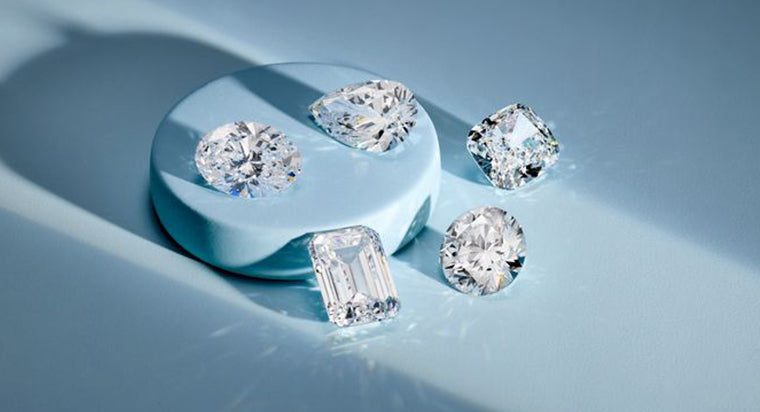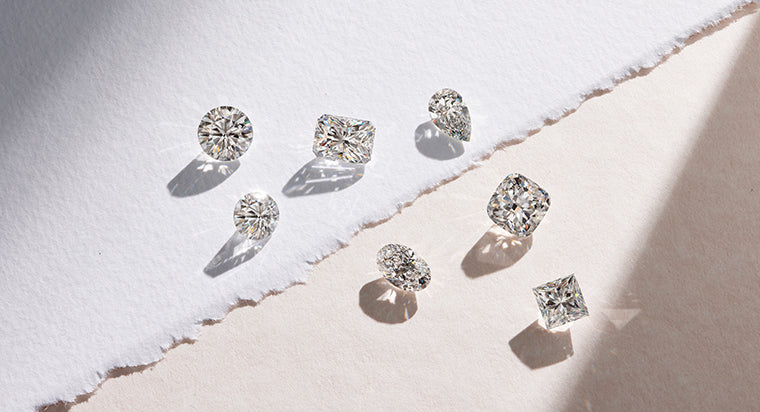Everything You Need to Know About Diamond Brilliance

If you're like many of us, you evaluate diamonds based on how much they sparkle in the light (hey, it's a legit way to decide). However, a diamond's sparkle isn't just one thing — it's actually a combination of three different components: fire, brilliance, and scintillation.
Fire is the colorful flashes that happen when a diamond disperses light. Scintillation is the flashing between light and shadow, which gives the blinking effect you love in a glittery stone. And as for diamond brilliance? It's the white flashes or white light return when it hits the light. But, how exactly can you measure that? Let's break down diamond brilliance — and learn how to evaluate it when deciding on a stone.
TABLE OF CONTENTS
What Exactly is Diamond Brilliance?
Believe it or not, diamonds don't come out of the earth looking amazing. Instead, they actually have a rough, opaque “skin” that is eventually removed through polishing and cutting. This diamond cutting and polish process helps mold (and reveal) diamond brilliance.
How so?
Think about diamond brilliance like a window. Light comes into a window based on how the glass absorbs it. Misshapen or imperfect glass won't bring in the light the same way a clear window pane will. The same goes for a diamond. A diamond with poor brilliance won't return light well and will look darker and lifeless, while a diamond with beautiful angles and a good cut will absorb — and throw back — plenty of light.

Cut and Polish are Essential for Diamond Brilliance
Why is diamond cut and polish such a big deal? It's simple: A diamond's cut can make — or break — its brilliance.
When a diamond is mined, a professional diamond cutter evaluates it to determine the best cut to maximize its size and natural properties, either a step cut or a brilliant cut. A step cut diamond naturally has fewer facets — or flat surfaces — on the crown (top) of the diamond and won’t reflect light as well. Step cut diamonds do, however, have more fire and they tend to show off the clarity of diamonds more than brilliants.
A brilliant cut, on the other hand, has more facets and will reflect more light and (naturally) have more brilliance.
But it Also Needs Scintillation
That said, a cut isn't the only aspect in determining diamond brilliance. Scintillation — or sparkle — is also needed.
Scintillation is a product of movement, meaning that either the diamond, light, or viewer must be in motion to see it. For this to happen there must be enough structural contrast in the facets to bounce light around.

Ideally, a brilliant diamond should have even and balanced scintillation — essentially, some facets should look dark while others flash. But it's a balancing act. Too much and the stone is too dark, too little and it doesn't have scintillation.
How to Make Sure you get a Brilliant Diamond
All of the talk of scintillation, cut, and facts is enough to make anyone’s head spin. So, how can you use this knowledge to get the best diamond brilliance in your engagement ring? Pay close attention to the cut grade. Cut and polish is where these effects are formed and you'll want excellent polish, finish, and cut to get the most brilliance. Diamonds that have all three excellent are considered Triple Excellent or Triple X diamonds.
But don't blindly buy one. Instead, talk to a gemologist so you can discuss pavilion angles (you don't want steep ones) and ideal cut (avoiding deep or shallow stones). At With Clarity, we have expert gemologists on staff who can explain diamond brilliance to you in depth and help you find the right diamond engagement ring for your dreams — and budget.
FAQs
What is diamond brilliance?
What is the brilliance of a round diamond?
Do lab diamonds have the same brilliance as natural diamonds?
Why does a diamond sparkle with great brilliance?
A diamond gets its brilliance from internal refraction because it has a high refractive index. Reflection, refraction, and dispersion give a diamond the sparkle that we have all come to love so much. It all comes down to light performance.
As light hits a diamond, it penetrates the diamond, bounces around and reflects within the diamond, and ultimately returns light to your eye. That is the sparkle that we see. The cutting of a diamond (angles, location, size, and shape of facets) directly impacts the brilliance.









